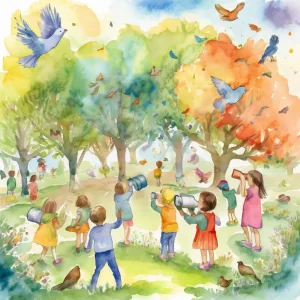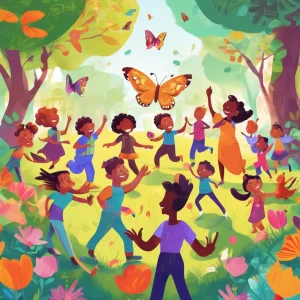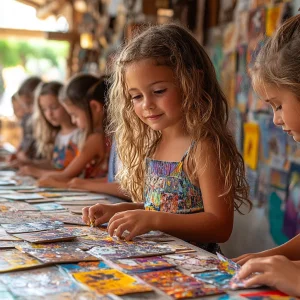Activity
Similar Activities
Nature Shapes Adventure: Bird Watch & Scavenger Hunt
Children’s Age: 4–5 years
Activity Duration: 10 minutes
An outdoor activity for children aged 4-5 years combining bird watching and shape recognition.
Activity Duration: 10 minutes
Enchanted Sound Symphony: Sensory Sound Walk
Children’s Age: 2 months – 3 years
Activity Duration: 5 – 25 minutes
Exploring sounds and textures through a sensory walk outdoors.
Activity Duration: 5 – 25 minutes
Adventure of Rhyme and Move Outdoor Magic
Children’s Age: 3–4 years
Activity Duration: 10 – 25 minutes
"Rhyme and Move Outdoor Adventure" is a fun activity that combines nature-themed rhymes with movement in an outdoor setting. Children get to explore the outdoors, practice language…
Activity Duration: 10 – 25 minutes
Magical Storytelling: Create Together with Friends
Children’s Age: 4–6 years
Activity Duration: 15 – 30 minutes
In the Create a Story Together activity, children will explore their creativity, language skills, and teamwork. Get small pieces of paper, colored pencils, and a container ready. K…
Activity Duration: 15 – 30 minutes
Enchanted Sensory Bottle Exploration for Little Ones
Children’s Age: 6 months – 1.5 years
Activity Duration: 5 minutes
Engage your child aged 6 to 18 months in a sensory bottle exploration activity to boost their communication, motor skills, and social-emotional development. Create a sensory bottle…
Activity Duration: 5 minutes
Earth's Natural Wonders: Creative Storytelling Journey
Children’s Age: 10–12 years
Activity Duration: 20 – 45 minutes
This activity is designed for children aged 10-12 to improve self-regulation and communication skills through creative storytelling about Earth's natural processes. With paper, cra…
Activity Duration: 20 – 45 minutes
Seasonal Poetry: A Language Exploration Journey
Children’s Age: 6–10 years
Activity Duration: 30 minutes
Explore the "Language Exploration Through Seasonal Poetry" activity to enhance children's communication and empathy skills through seasonal poems. Gather materials like poems, pape…
Activity Duration: 30 minutes
Sensory Nature Walk: A Baby's Adventure Outdoors
Children’s Age: 0 – 6 months
Activity Duration: 10 minutes
Engage infants aged 0 to 6 months in sensory exploration with the Sensory Nature Walk activity. Gather essentials like a baby carrier, sunscreen, and soft toys for a safe outdoor e…
Activity Duration: 10 minutes
Whispers of the Forest: Sensory Scarves Exploration
Children’s Age: 6 months – 1 year
Activity Duration: 5 minutes
Engage infants aged 6 to 12 months in the "Sensory Scarves Exploration" activity, a solo play experience using colorful scarves to promote physical development. Set up a safe play …
Activity Duration: 5 minutes
Holiday Magic: Baby Sensory Play Wonderland
Children’s Age: 1 – 3 months
Activity Duration: 5 – 10 minutes
Engage your 0 to 3-month-old baby in a soothing holiday sensory play experience to aid their physical development. Gather soft holiday fabric, small toys, and maybe some festive mu…
Activity Duration: 5 – 10 minutes
Whispers of the Forest: Counting and Sorting Nature Scavenger Hunt
Children’s Age: 3–5 years
Activity Duration: 5 – 15 minutes
The Counting and Sorting Nature Scavenger Hunt is perfect for children aged 36 to 60 months, fostering self-regulation, communication, and basic math skills in a delightful way. Ch…
Activity Duration: 5 – 15 minutes
Cultural Collage Celebration: Embracing Diversity Through Art
Children’s Age: 6–10 years
Activity Duration: 15 minutes
Explore and celebrate cultural diversity with the "Cultural Collage Celebration" activity designed for children. Enhance academic skills by creating a collaborative cultural collag…
Activity Duration: 15 minutes



























